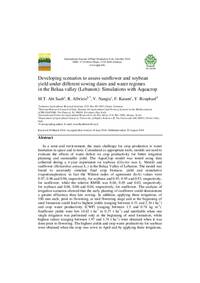Developing scenarios to assess sunflower and soybean yield under different sowing dates and water regimes in the Bekaa valley (Lebanon): Simulations with Aquacrop

Authors:
In a semi-arid environment, the main challenge for crop production is water
limitation in space and in time. Considered as appropriate tools, models are used to
evaluate the effects of water deficit on crop productivity for better irrigation
planning and sustainable yield. The AquaCrop model was tested using data
collected during a 4-year experiment on soybean (Glycine max L. Merril) and
sunflower (Helianthus annuus L.) in the Bekaa Valley of Lebanon. The model was
found to accurately simulate final crop biomass, yield and cumulative
evapotranspiration: in fact the Wilmot index of agreement (IoA) values were
0.97, 0.96 and 0.96, respectively, for soybean and 0.93, 0.95 and 0.93, respectively,
for sunflower, while the relative RMSE was 0.04, 0.05 and 0.02, respectively,
for soybean and 0.04, 0.06 and 0.04, respectively, for sunflower. The analysis of
irrigation scenarios showed that the early planting of sunflower could demonstrate
a greater efficiency than late sowing. In addition, applying three irrigations, of
100 mm each, prior to flowering, at mid flowering stage and at the beginning of
seed formation could lead to highest yields (ranging between 4.51 and 2.34 t ha-1)
and crop water productivity (CWP) (ranging between 1.5 and 0.78 kg m-3).
Sunflower yields were low (0.42 t ha-1 to 0.37 t ha-1) and unreliable when one
single irrigation was performed only at the beginning of seed formation, while
highest values (ranging between 1.97 and 1.74 t ha-1) were obtained when it was
done prior to flowering. The highest yields and crop water productivity for soybean
were obtained when the crop was sown in April and by applying three irrigations of 100 mm each, at full bloom, at seed enlargement and at mature seeds. Soybean
yield values ranged between 3.16 and 2.01 t ha-1, while CWP values varied from
1.05 to 0.67 kg m-3. However, irrigating at seed enlargement and mature seeds, as
well as applying only one irrigation of 100 mm at any growth stage, could lead to
very low yields and CWP.
